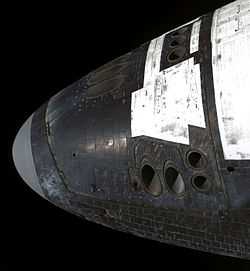Reaction control system

A reaction control system (RCS) is a spacecraft system that uses thrusters to provide attitude control, and sometimes translation. Use of diverted engine thrust to provide stable attitude control of a short-or-vertical takeoff and landing aircraft, below conventional winged flight speeds, such as the Harrier "jump jet", may also be referred to as a reaction control system.
An RCS is capable of providing small amounts of thrust in any desired direction or combination of directions. An RCS is also capable of providing torque to allow control of rotation (roll, pitch, and yaw).
RCS systems often use combinations of large and smaller (vernier) thrusters, to allow different levels of response. Spacecraft reaction control systems are used:
- for attitude control during re-entry;
- for stationkeeping in orbit;
- for close maneuvering during docking procedures;
- for control of orientation, or 'pointing the nose' of the craft;
- as a backup means of deorbiting;
- as ullage motors to prime the fuel system for a main engine burn;
Because spacecraft only contain a finite amount of fuel and there is little chance to refill them, some alternative reaction control systems have been developed so that fuel can be conserved. For stationkeeping, some spacecraft (particularly those in geosynchronous orbit) use high-specific-impulse engines such as arcjets, ion thrusters, or Hall effect thrusters. To control orientation, a few spacecraft, including the ISS, use momentum wheels which spin to control rotational rates on the vehicle.
Location of thrusters on spacecraft
Two Apollo spacecraft (the Service Module and the Lunar Module) had translation thrusters, R-4D, grouped into external blocks of four, which served to translate and orient the spacecraft. Other designs used separate sets of thrusters for these two tasks. The Apollo thrusters were configured to allow "coupled" RCS firings (where thrusters on opposite sides of the spacecraft fired together), which allowed adjusting the vehicle attitude without affecting the critical accuracy of their orbital, trans-lunar and trans-earth trajectories.
The Mercury and Gemini spacecraft each had groupings of two nozzles inserted into their forward compartments, with slots cut out from which the exhaust could escape. These thrusters were used for orientation, not translation. (Indeed, the Mercury spacecraft had no separate capacity for translation at all.) Similarly, the command modules of both the Apollo and Soyuz spacecraft have their re-entry RCS thrusters ungrouped.
A pair of translation thrusters are located at the rear of the Soyuz spacecraft; the counter-acting thrusters are similarly paired in the middle of the spacecraft (near the center of mass) pointing outwards and forward. These act in pairs to prevent the spacecraft from rotating. The thrusters for the lateral directions are mounted close to the center of mass of the spacecraft, in pairs as well.
Location of thrusters on spaceplanes

The suborbital X-15 and a companion training aero-spacecraft, the NF-104 AST, both intended to travel to an altitude that rendered their aerodynamic control surfaces unusable, established a convention for locations for thrusters on winged vehicles not intended to dock in space; that is, those that only have attitude control thrusters. Those for pitch and yaw are located in the nose, forward of the cockpit, and replace a standard radar system. Those for roll are located at the wingtips. The X-20, which would have gone into orbit, continued this pattern.
Unlike these, the Space Shuttle Orbiter had many more thrusters, as it was required to carry out docking maneuvers in orbit. Shuttle thrusters were grouped in the nose of the vehicle and on each of the two aft Orbital Maneuvering System pods. No nozzles interrupted the heat shield on the underside of the craft, instead, the nose RCS nozzles which control positive pitch were mounted on the side of the vehicle, and were canted downward. The downward-facing negative pitch thrusters were located in the OMS pods mounted in the tail/afterbody.
Space station systems
The International Space Station uses electrically powered reaction control gyroscopes for primary attitude control, with RCS thruster systems as backup and augmentation systems.[1]
See also
- Attitude dynamics and control
- Attitude control system